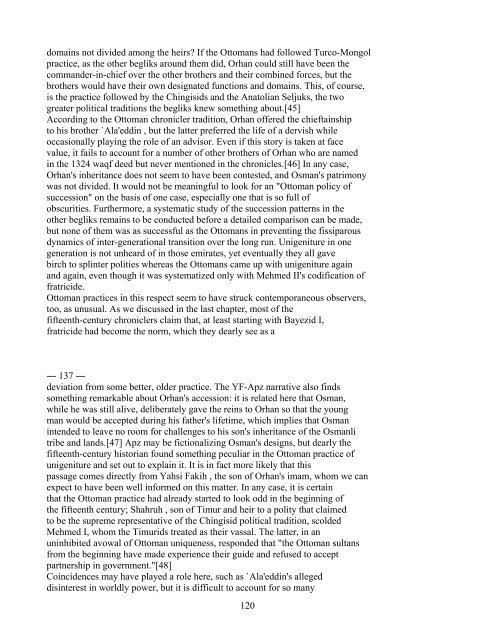Between Two Worlds Kafadar.pdf
Between Two Worlds Kafadar.pdf
Between Two Worlds Kafadar.pdf
You also want an ePaper? Increase the reach of your titles
YUMPU automatically turns print PDFs into web optimized ePapers that Google loves.
domains not divided among the heirs? If the Ottomans had followed Turco-Mongol<br />
practice, as the other begliks around them did, Orhan could still have been the<br />
commander-in-chief over the other brothers and their combined forces, but the<br />
brothers would have their own designated functions and domains. This, of course,<br />
is the practice followed by the Chingisids and the Anatolian Seljuks, the two<br />
greater political traditions the begliks knew something about.[45]<br />
According to the Ottoman chronicler tradition, Orhan offered the chieftainship<br />
to his brother `Ala'eddin , but the latter preferred the life of a dervish while<br />
occasionally playing the role of an advisor. Even if this story is taken at face<br />
value, it fails to account for a number of other brothers of Orhan who are named<br />
in the 1324 waqf deed but never mentioned in the chronicles.[46] In any case,<br />
Orhan's inheritance does not seem to have been contested, and Osman's patrimony<br />
was not divided. It would not be meaningful to look for an "Ottoman policy of<br />
succession" on the basis of one case, especially one that is so full of<br />
obscurities. Furthermore, a systematic study of the succession patterns in the<br />
other begliks remains to be conducted before a detailed comparison can be made,<br />
but none of them was as successful as the Ottomans in preventing the fissiparous<br />
dynamics of inter-generational transition over the long run. Unigeniture in one<br />
generation is not unheard of in those emirates, yet eventually they all gave<br />
birch to splinter polities whereas the Ottomans came up with unigeniture again<br />
and again, even though it was systematized only with Mehmed II's codification of<br />
fratricide.<br />
Ottoman practices in this respect seem to have struck contemporaneous observers,<br />
too, as unusual. As we discussed in the last chapter, most of the<br />
fifteenth-century chroniclers claim that, at least starting with Bayezid I,<br />
fratricide had become the norm, which they dearly see as a<br />
― 137 ―<br />
deviation from some better, older practice. The YF-Apz narrative also finds<br />
something remarkable about Orhan's accession: it is related here that Osman,<br />
while he was still alive, deliberately gave the reins to Orhan so that the young<br />
man would be accepted during his father's lifetime, which implies that Osman<br />
intended to leave no room for challenges to his son's inheritance of the Osmanli<br />
tribe and lands.[47] Apz may be fictionalizing Osman's designs, but dearly the<br />
fifteenth-century historian found something peculiar in the Ottoman practice of<br />
unigeniture and set out to explain it. It is in fact more likely that this<br />
passage comes directly from Yahsi Fakih , the son of Orhan's imam, whom we can<br />
expect to have been well informed on this matter. In any case, it is certain<br />
that the Ottoman practice had already started to look odd in the beginning of<br />
the fifteenth century; Shahruh , son of Timur and heir to a polity that claimed<br />
to be the supreme representative of the Chingisid political tradition, scolded<br />
Mehmed I, whom the Timurids treated as their vassal. The latter, in an<br />
uninhibited avowal of Ottoman uniqueness, responded that "the Ottoman sultans<br />
from the beginning have made experience their guide and refused to accept<br />
partnership in government."[48]<br />
Coincidences may have played a role here, such as `Ala'eddin's alleged<br />
disinterest in worldly power, but it is difficult to account for so many<br />
120













